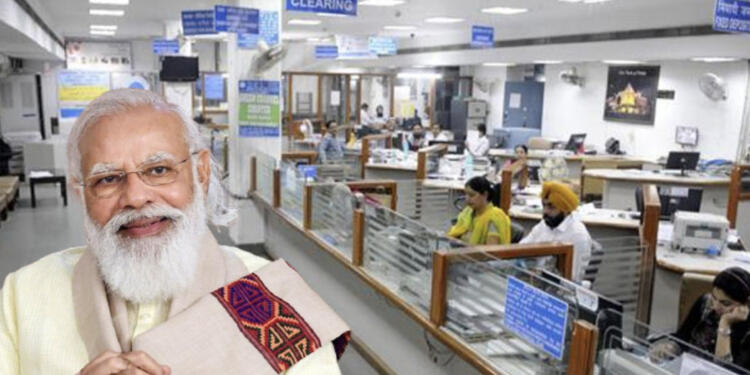A recent report by SBI’s group chief economic adviser Soumya Kanti Ghosh has revealed that boosted by the Pradhan Mantri Jan Dhan Yojana, the number of bank branches per 100,000 adults in India rose to 14.7 in 2020 from 13.6 in 2015. The financial inclusion metrics state that India has beaten the likes of China, Germany, and South Africa.
The report read, “India has stolen a march in financial inclusion with the initiation of PMJDY accounts since 2014, enabled by a robust digital infrastructure and also careful recalibration of bank branches and thereby using the BC model judiciously for furthering financial inclusion.”
It further added, “Such financial inclusion has also been enabled by use of digital payments as between 2015 and 2020, mobile and internet banking transactions per 1,000 adults have increased to 13,615 in 2019 from 183 in 2015,”
Financial inclusion has a multiplier effect
Moreover, the number of ‘Banking Outlets in Villages has risen from 34,174 in Mar’10 to 12.4 lakh in Dec’20. The SBI report clearly states that financial inclusion policies have a multiplier effect on economic growth, income inequality, and reducing poverty. It is also conducive to financial stability.
Also, states having higher Pradhan Mantri Jan-Dhan Yojana (PMJDY) accounts balances have reported a decline in crime. While SBI is stating the obvious now, much of it was envisaged by PM Modi, back in 2014.
Jan Dhan Yojana – the precursor for all things to come
India for a long time struggled in including a significant part of its population in the banking sector. However, unlike previous government regimes, the Modi administration did not attempt to reboot the economy without correcting the anomalies or fixing the foundation.
It immediately got down to brass tacks, launched the ambitious Jan Dhan Yojana, and brought the rural population in touch with the banking sector.
The incentive was clear to the layman – simply open a bank account without depositing a penny and become part of the banking revolution. There was no compulsion to deposit a single penny but PM Modi understood that Indians by habit are likely to save and deposit money, even if it is a tiny fraction of their income.
Indians took to banking like a duck to water
As a result, according to 2020 data, there were over 40 crore beneficiaries of this scheme with deposits in the Jan Dhan bank accounts crossing the Rs 1.30 lakh crore mark.
Imagine a simple idea of opening a bank account leading to such mind-boggling numbers being pumped into the Indian economy. PM Modi thought about it and implemented it.
And much like the naysayers who laughed at him for talking about Toilets and Swacch Bharat from the ramparts of Red Fort in his first speech, PM Modi completed his mission.
In view of the runaway success of the scheme, the government in 2018 enhanced the accident insurance cover to Rs 2 lakh, from Rs 1 lakh for new accounts opened after August 28, 2018.
Read More: The success story of Jan Dhan Yojna is out and its a lesson in financial inclusion.
Direct Benefit Transfer – world’s most efficient money transfer scheme
However, the opening of bank accounts was just a stepping point for the grander scheme of things the Modi government had in the pipeline. Then came the Direct Benefit Transfer (DBT) scheme which revolutionized the way money was transferred to the public.
Former PM Rajiv Gandhi has famously remarked that only 15 paise of every rupee meant for the welfare of the downtrodden reached the poor. However, owing to the DBT scheme, not a single paisa is wasted or usurped by the middlemen.
While implementing DBT, India has efficiently used the Jan Dhan-Aadhar-Mobile (JAM) trinity. Entrepreneurs like Bill Gates, who have worked on public policy and welfare issues in countries around the world, called JAM the most sophisticated way of transferring money to citizens.
As reported by TFI, in 2016-17 alone, the government plugged leakage worth Rs. 32,984 crores through the scheme. DBT also made the transfer of MGNREGA benefits more transparent and efficient.
A revolution in the digital payment sector- all courtesy PMJDY
A direct benefit of Jan Dhan bank accounts can be witnessed with the digital payment revolution in the country. According to data from the National Payments Corporation of India (NPCI), the value of transactions made using the Unified Payments Interface (UPI) for the first time crossed $100 billion in a month in October.
From a big tier-1 city to every nook and cranny of a tier-3,4 city, even villages- the scale of UPI penetration across India is no less than a miracle. However, this miracle has been made possible by the sky-high ambitions of the current administration.
Read More: How PM Modi took India from a distant second to a dominant first in e-Payments
UPI has been so impressive and successful that PayTM, Walmart-owned PhonePe, and Google Pay also adopted it. Today, UPI is the most preferred system of instant payments in the country, because it does not operate as a digital wallet and enables seamless transfer of money into bank accounts.
China was leading the e-payments market when PM Modi came to power, but over the last six-seven years, digital payment has witnessed brisk growth to make India a world leader.































